Starter Overhaul 28-MT
Introduction
If the motor does not perform to specifications, the motor may be disassembled
for further testing of the components. Normally, the starter motor should
be disassembled only so far as is necessary to complete repair or replacement
of parts.
For 28-MT starter motor and components, refer to
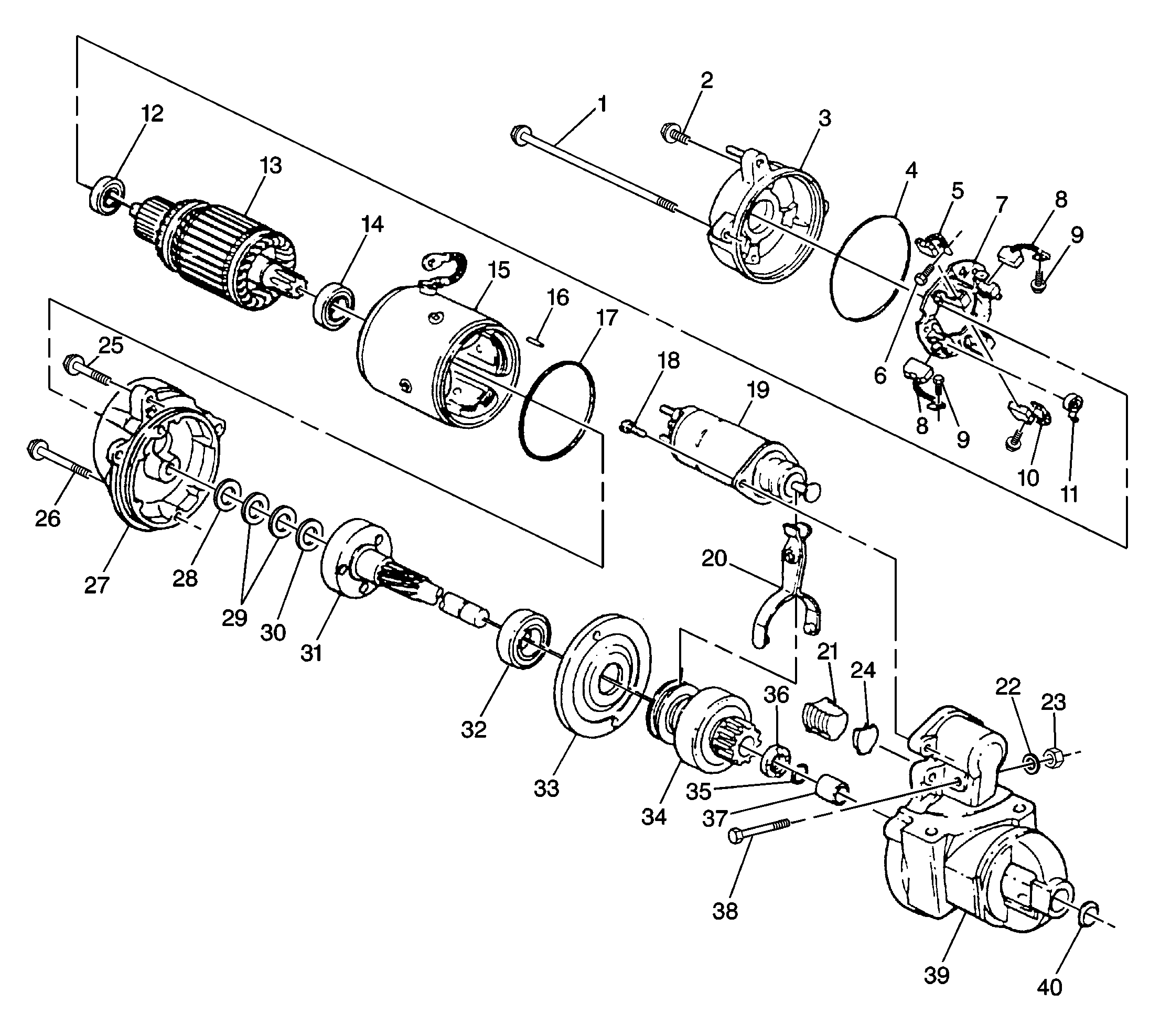
Do not disassemble the following components that are serviced as assemblies:
| • | The clutch drive assembly |
| • | The brush holder assembly |
| • | The frame and field assembly |
Unit Disassembly Procedure
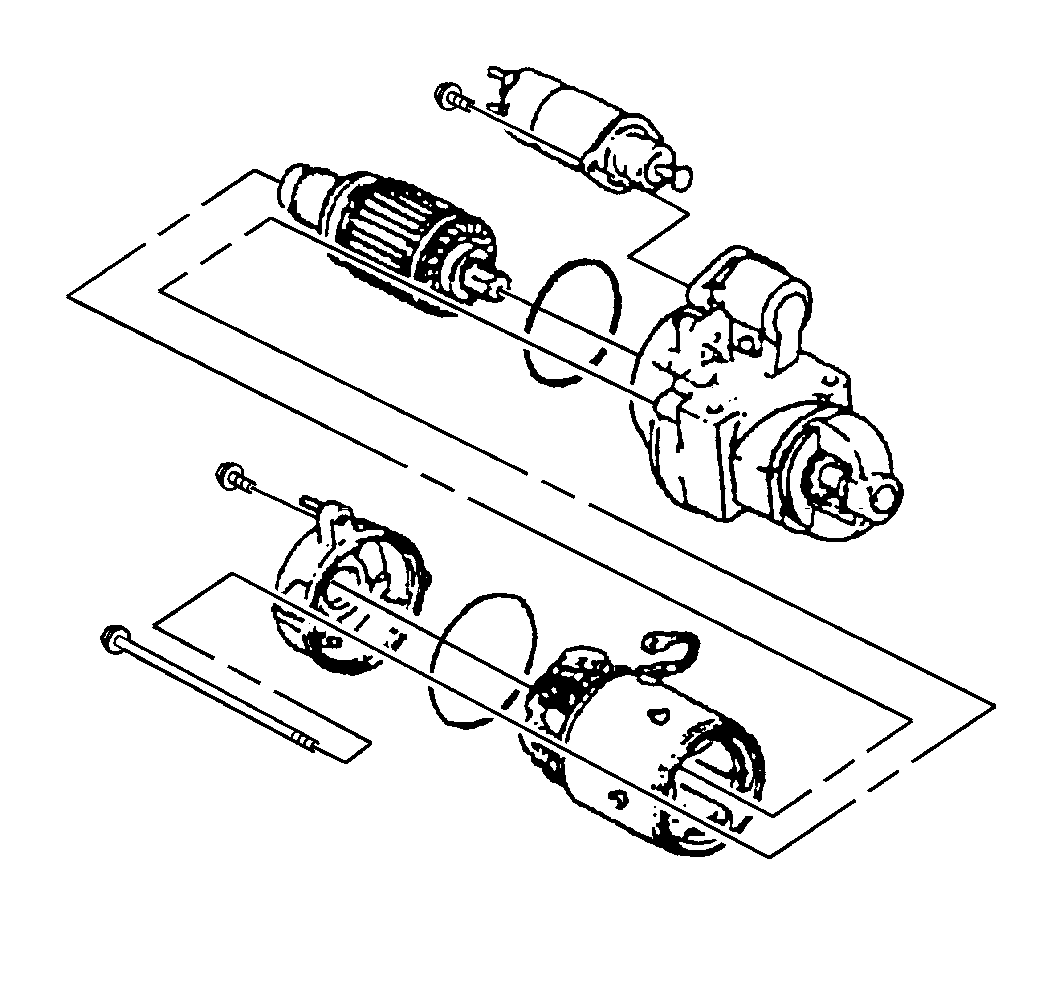
Caution: Wear safety glasses in order to avoid eye damage.
Important: Use a colored pencil or marker that will show on all parts.
- Make alignment marks completely down one side of the starter motor in
order to ensure proper alignment of all components during reassembly.
- Remove the nut of the motor lead to the solenoid assembly.
| 2.1. | Disconnect the motor lead from the solenoid assembly. |
- Remove the two through bolts.
- Remove the two brush plate screws.
- Remove the commutator end frame and the O-ring seal.
Important: Do not lose the small dowel pin installed between the frame assembly
and the gear reduction and drive group. If the dowel pin is lost, replace
the dowel pin with a 2 mm x 10 mm (0.079 in x 0.394 in)
long pin obtained or manufactured locally.
Important: The armature assembly may come off with the frame, field, and brush
holder group, or the armature assembly may be retained by the gear reduction
and drive group.
- Remove the frame, field, and brush holder group, dowel pin, and O-ring
seal.
Important: Do not remove the bearings from the armature assembly unless replacement
is required. Refer to
Starter Motor Inspection
.
- Remove the armature assembly with the bearings.
- Remove the solenoid screws.
- Pivot the inside end of the solenoid assembly out of the engagement
shift lever drive group.
- Remove the solenoid assembly.
Frame, Field, And Brush Holder Group Disassembly Procedure
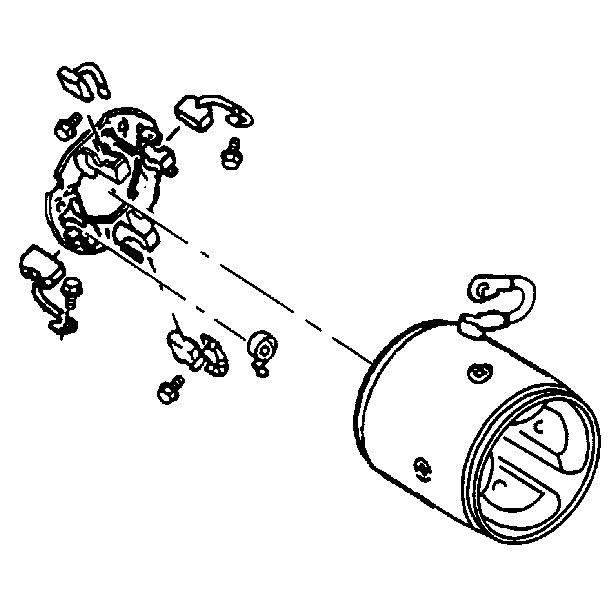
- Move the brush holder
assembly with the brushes slightly away from the frame and field assembly.
Remove the insulated brush screws.
- Remove the frame and field assembly.
- Remove the grounded brush screws.
- Remove any brushes that need replacement.
- Inspect for any brush springs that need replacement. Remove the
brush springs.
| 5.1. | Grasp the brush end of each brush spring with needle-nose pliers. |
| 5.2. | Twist the spring end away from the brush and remove the brush. |
- Inspect and test all electrical components. Refer to
Starter Motor Inspection
.
Gear Reduction And Drive Group Disassembly Procedure
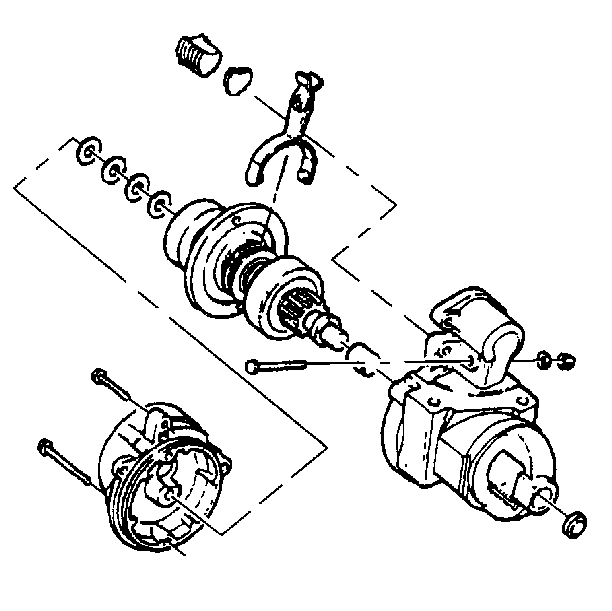
- Remove the housing bolts.
Important: Washers may stick to the bracket or to the driveshaft and clutch group
as the bracket is removed. In either case, note the position and number of
each of the washers.
- Remove the armature support bracket.
- Remove the washers.
- Pry out the drive housing plug with a large screwdriver. Remove
the plate.
- Remove the shift lever nut, washer, and screw.
Important: Do not remove the bushing plug or the bushing from the drive housing
unless replacement is indicated. Refer to
Starter Motor Inspection
.
- Remove the shift lever and driveshaft and clutch group from the drive
housing together.
- Separate the shift lever and driveshaft and clutch group.
Driveshaft And Clutch Group Disassembly Procedure
Disassemble the driveshaft and clutch group only when necessary in order
to clean, inspect, or replace one or more parts of the group separately.
- Remove the stop rings and the pinion stop.
| 1.1. | Position the driveshaft and clutch group on a work bench with
the internal gear end down. |
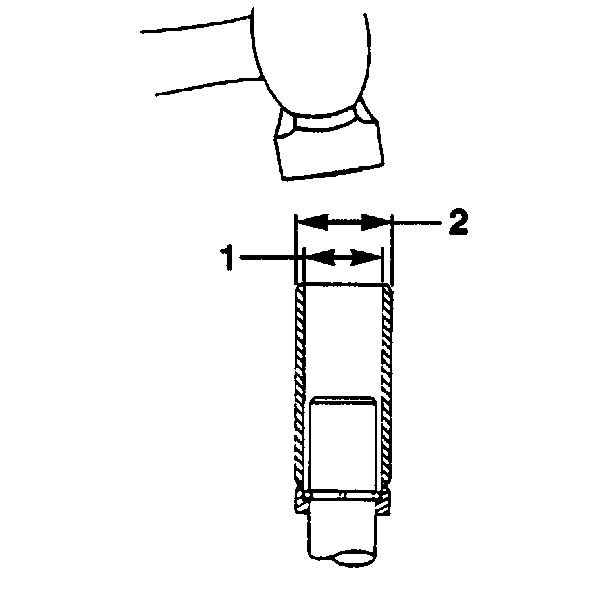
| 1.2. | Place an open tube with
a diameter (2) of 22 mm (0.87 in) over the slightly smaller
14.2 mm (0.60 in) diameter (1) of the shaft. |
| 1.3. | With the tube, drive the pinion stop toward the clutch drive until
the pinion stop clears the stop ring. |
| 1.4. | Pry the stop rings out of the driveshaft groove. Slide the stop
rings off the shaft, being careful not to scratch the driveshaft. |
| 1.5. | Inspect the edges of the shaft groove for burrs. Burrs may make
removal of the pinion stop and clutch drive assembly difficult. |
| 1.5.1. | If burrs are found, use a file in order to carefully remove the
burrs without damaging the base metal. |
| 1.5.2. | Thoroughly clean away any metal filings. |
| 1.6. | Slide the pinion stop off the driveshaft. Discard the old pinion
stop and stop rings. |
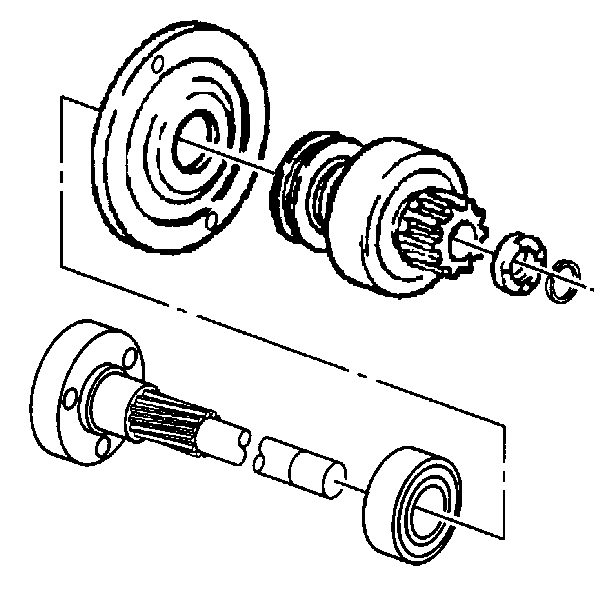
- Remove the clutch drive
assembly from the driveshaft.
- Remove the driveshaft support from the driveshaft.
- Only if the bearing needs replacement, remove the bearing from
the driveshaft. Refer to
Starter Motor Inspection
.
Drive Shaft And Clutch Group Assembly Procedure
If disassembled, position the driveshaft on a work surface with the
internal gear end down.

Important: If the center support bearing is being replaced, install the center
support bearing on the driveshaft. Refer to
Starter Motor Inspection
.
- Install the driveshaft support to the driveshaft, seating the bearing
in the support.
- Install the clutch drive assembly to the driveshaft.

- Install a new pinion stop
and stop rings.
| 3.1. | Slide the pinion stop with the recess for stop rings facing up
onto the driveshaft. |
| 3.2. | Position a block at least 38 mm (1.5 in) wide in
a vise. |
| 3.3. | Support the assembly under the pinion stop in the metal block
with a U-shaped cutout with a width of 14.2 mm (0.56 in). |
| 3.4. | Make sure the stop rings in the driveshaft groove are fully seated
in the recess of the pinion stop. |
| | Important: Keep the staked metal from contact with the driveshaft.
|
| 3.5. | Stake the upper edge of the pinion stop over the stop ring at four places,
equally spaced. |
Gear Reduction And Drive Group Assembly Procedure

Important: If the drive end bushing and plug are being replaced, install the drive
end bushing and plug in the drive housing. Lubricate the drive end housing
bushing, shift lever, and driveshaft. Refer to
Starter Motor Inspection
.
- Install the arms of the shift lever with the shift collar onto the driveshaft
and clutch group.

- Install the assembled
shift lever and driveshaft and clutch group into the drive housing.
| 2.1. | Align the holes in the driveshaft support with those in the drive
housing. |
| 2.2. | Make sure that the driveshaft support is fully seated in the drive
housing and the driveshaft bearing remains fully seated in the driveshaft
support. |

Notice: Use the correct fastener in the correct location. Replacement fasteners
must be the correct part number for that application. Fasteners requiring
replacement or fasteners requiring the use of thread locking compound or sealant
are identified in the service procedure. Do not use paints, lubricants, or
corrosion inhibitors on fasteners or fastener joint surfaces unless specified.
These coatings affect fastener torque and joint clamping force and may damage
the fastener. Use the correct tightening sequence and specifications when
installing fasteners in order to avoid damage to parts and systems.
- Install the shift
lever screw, washer, and nut.
Tighten
Tighten the shift lever nut to 4.5 N·m (40 lb in).
- Install the plate, if used, and the drive housing plug to the
drive housing.
- Install the washers in the same number and position as noted during
disassembly.
- Install the armature support bracket to the drive housing.
- Install the drive housing bolts.
Tighten
Tighten the drive housing bolts to 8.5 N·m (75 lb in).
Frame, Field, And Brush Holder Group Assembly Procedure
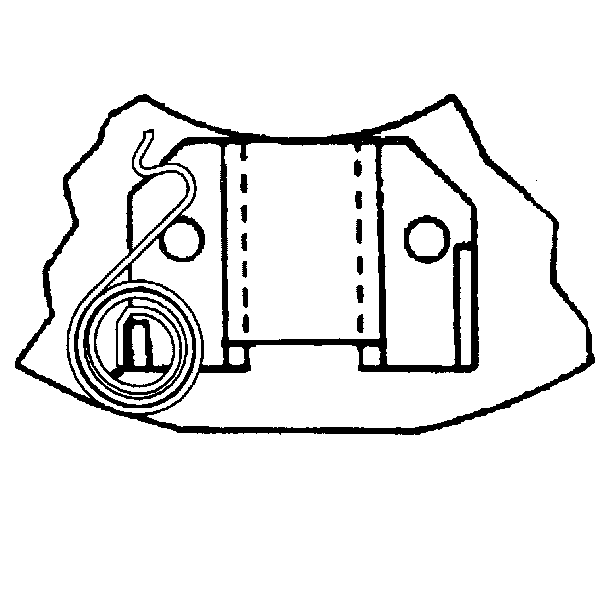
- Install the brush springs,
if removed.
| 1.1. | Start each spring onto the post on the brush holder assembly just
enough in order to keep the inside end of the spring from turning. |
| 1.2. | Grasp the free end of the spring with needle nose pliers and twist
the spring to the right over the top of the brush socket. |
| 1.3. | Push the spring fully onto the post and release the free end in
order to engage the notch in the brush socket. |
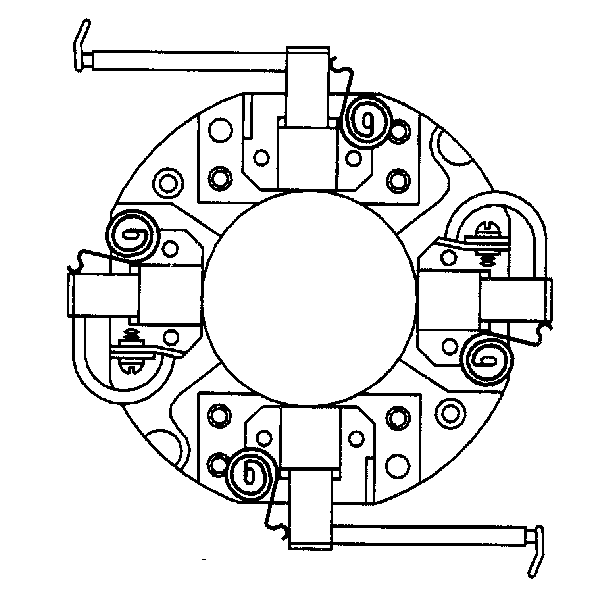
Notice: Brush leads may be damaged by excessive handling. Do not overflex the
leads near the clip welds or the clips may break
- Install the brushes, if removed
| 2.1. | Make sure the insulated brushes go into the brush sockets of the
brush holder assembly that mounts on the insulation. |
| 2.2. | Grasp the free end of the brush spring with needle nose pliers. |
| 2.3. | Twist the spring to the right in order to clear the brush socket.
Insert the brush partly into the brush socket. |
| | Important: This will hold the brushes retracted until the brush holder is installed
over the armature commutator.
|
| 2.4. | Gradually release the spring so that the end of the spring contacts
the side, not the end, of the brush. |
- Install the grounded brush screws.
| 3.1. | Position the terminals of the grounded brush leads behind the
terminal tabs on the brush holder. |
| 3.2. | Insert the brush screws through the terminal tabs on the brush
holder. Thread the screws into the brush lead terminals. |
Tighten
Tighten the grounded brush screws to 1.5 N·m (13 lb in).

- Install the frame and
field assembly to the brush holder assembly.
| 4.1. | Position the brush holder assembly with the brushes installed
over the terminal end of the frame and field assembly. |
| 4.2. | Attach the terminals of the insulated brush leads to the conductors
in the frame and field assembly with insulated brush screws. |
Tighten
Tighten the insulated brush screws to 1.5 N·m (13 lb in).
Unit Assembly Procedure
- Support the gear reduction and drive group with the pinion gear
end down.

Notice: Use the correct fastener in the correct location. Replacement fasteners
must be the correct part number for that application. Fasteners requiring
replacement or fasteners requiring the use of thread locking compound or sealant
are identified in the service procedure. Do not use paints, lubricants, or
corrosion inhibitors on fasteners or fastener joint surfaces unless specified.
These coatings affect fastener torque and joint clamping force and may damage
the fastener. Use the correct tightening sequence and specifications when
installing fasteners in order to avoid damage to parts and systems.
Important: If the armature bearings are being replaced, install the armature bearings
on the armature. Refer to
Starter Motor Inspection
.
- Install the solenoid assembly.
| 2.1. | Pivot the plunger of the solenoid assembly into the engagement
with the shift lever in the gear reduction and drive group. |
| 2.2. | Position the solenoid assembly mounting flange and install the
solenoid mounting screws. |
Tighten
Tighten the solenoid mounting screws to 2.8 N·m (25 lb in).
- Install the frame seal.
- Install the armature assembly with the bearings into the gear
reduction and drive group.
| 4.1. | Make sure the gear teeth of the armature are aligned. |
| 4.2. | Fully seat the bearing on the armature into the housing recess. |
- Install the frame, field, and brush holder group.
| 5.1. | Place the dowel pin in the hole of the armature support bracket
of the gear reduction and drive group. |
| 5.2. | Position the frame, field, and brush holder group over the armature
assembly. Align the hole for the dowel pin and the alignment marks. |
| 5.3. | Seat the frame, field, and brush holder group in the gear reduction
and drive group. |

| | Important: Brush spring tension should be 44.5 -49.0 N (10-11 lbs).
If not, replace the springs before proceeding.
|
| 5.4. | Twist the brush springs away from the brushes. Slide the brushes into
contact with the commutator on the armature. |
| 5.5. | Release the brush springs in order to contact the ends of the
brushes. |

Important: The O-ring seal can easily be damaged during installation of the commutator
end frame. Carefully follow the installation procedure.
- Install the 0-ring seal on the frame, field, and brush holder group.
| 6.1. | Install the 0-ring seal so that the seal is against the shoulder
of the field frame that will abut the commutator end frame when installed. |
| 6.2. | Carefully roll the 0-ring seal out of the installed position and
up onto the major outer diameter of the field frame. |
| 6.3. | Allow the seal to remain in this position until the commutator
end frame is partially installed. |

- Install the commutator
end frame.
| 7.1. | Align the marks made prior to disassembly on the commutator end
frame and the frame and field assembly. |
| 7.2. | Start the commutator end frame onto the frame and field assembly,
but leave a gap just slightly larger than the thickness of the 0-ring seal. |
| 7.3. | Use a scribe or similar tool to align the tapped holes in the
brush holder assembly with the screw holes in the commutator end frame. |
| 7.4. | Install the brush plate screws. |
Tighten
Tighten the brush plate screws to 2.8 N·m (25 lb in).
- Install the through-bolts.
| 8.1. | Tighten the through-bolts by hand, but do not close the gap left
for the seal between the end frame and the frame and field assembly. |
| 8.2. | Roll the 0-ring seal into the installed position between the commutator
end frame and the frame and field assembly. |
| | Important: Marks are located in two places on the motor, but will only match one
way in order to ensure proper alignment.
|
| 8.3. | Align the timing ribs on the edge of the commutator end frame with the
timing spots on the frame and field assembly. |
Tighten
Tighten the through-bolts to 8.5 N·m (75 lb in).

- Connect the motor lead
onto the frame and field assembly.
| 9.1. | Remove the nut from the terminal on the solenoid. |
| 9.2. | Install the motor lead terminal. Reinstall the nut. |
Tighten
Tighten the solenoid motor terminal nut to 11 N·m (100 lb in).
- After completion of the overhaul of the starter motor, do a starter
no load test. Refer to
Starter No Load Test
.
Starter Overhaul SD Series
Solenoid Disassembly Procedure
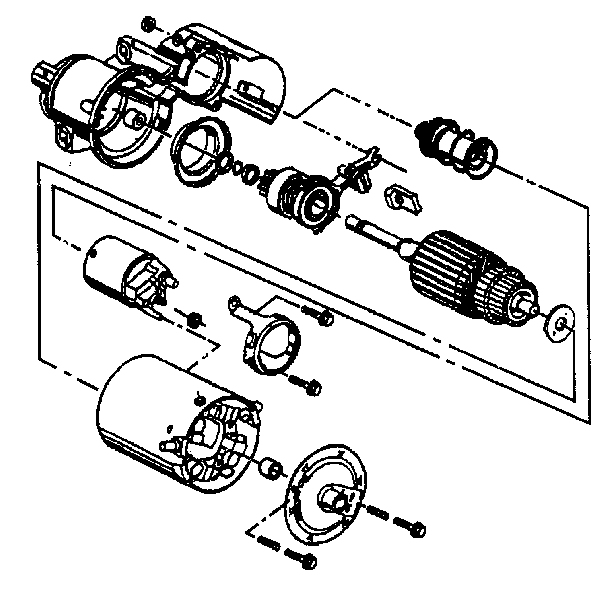
- Clean the outside of the
starter housing.
- Make scribe marks to show the relationship of the drive end frame,
frame and field assembly, and the end frame to aid in assembly.
- Note the position of the through-bolts.
- Models with solenoid shield:
| • | Solenoid shield nuts from the solenoid clamp screws. |
| • | Shield from the solenoid. |
| • | Motor lead attaching nut and lead from the solenoid. |
| • | Solenoid clamp attaching screws, clamp, and solenoid from the
frame assembly. |
Frame and Field Disassembly Procedure

- Disassemble the through
bolts from the end frame.
- Disassemble the end frame.
- Disassemble the brake washer from the armature assembly.
- Disassemble the frame and field from the armature/drive and frame
assembly.
Drive-End Frame Disassembly Procedure
- Disassemble the plug from the drive end frame assembly.

- Disassemble the armature
with the drive assembly, shift lever, plunger and return spring from the
drive end frame.
- Disassemble the return spring from the plunger.
- Disassemble the plunger from the shift lever.
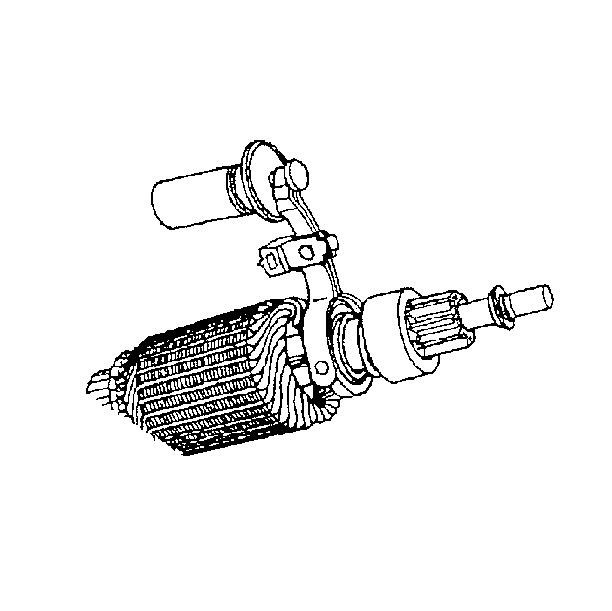
- Disassemble the shift
lever from the drive assembly by spreading the lever arms slightly to snap
them off the mating buttons on the drive collar.
- Disassemble the drive assembly from the armature shaft in the
following way:
| • | Remove the thrust collar away from the armature shaft. |
| • | Drive the pinion stop collar away from the pinion stop retainer
ring by sliding a metal cylinder onto the armature shaft. Strike the metal
cylinder against the stop collar with a hammer. |
| • | Spread the pinion stop retainer ring to remove it from the groove
in the armature shaft. Discard the old ring. The retainer ring must be replaced. |
| • | Slide the stop collar and the drive assembly off the armature
shaft. |
Drive-End Frame Assembly Procedure
If disassembled, position the driveshaft on a work surface with the
internal gear end down. Assemble the driveshaft and clutch group in the following
way:

Important: If the center support bearing is being replaced, install it on the driveshaft.
- Install the driveshaft support to the driveshaft, seating the bearing
in the support.
- Install the clutch drive assembly to the driveshaft.
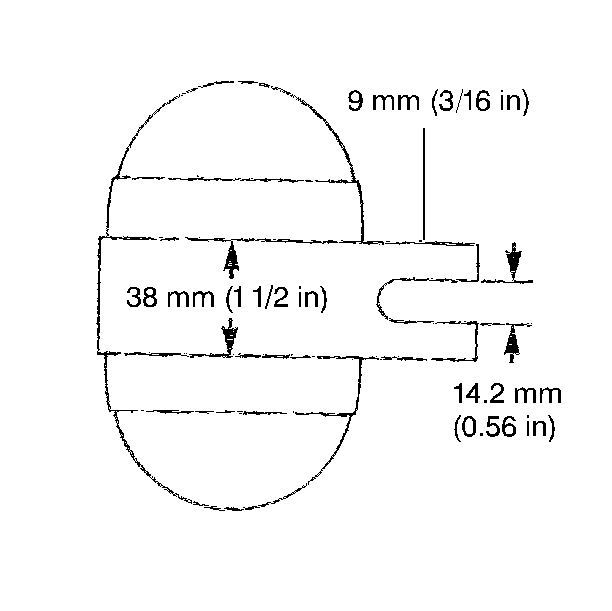
- Install the new pinion
stop onto the driveshaft.
| • | Slide the pinion stop onto the driveshaft until recess for the
stop rings faces up. |
| • | Install the stop rings into the groove in the driveshaft. |
| • | Pick the assembly up and support it under the pinion stop. A metal
block, with a U-shaped cutout that will slide over the shaft between the pinion
gear and stop, can be clamped in a vise to provide support. |
| • | Make sure the stop rings are fully seated in the pinion stop recess.
Stake the upper edge of the pinion stop over the stop ring at four equally
spaced places. Do not allow the staked metal to contact the driveshaft. |
Frame and Field Assembly Procedure

- Assemble the frame and
field assembly onto the armature.
| • | Clean the contact faces of the brushes and the commutator with
a soft cloth. |
| • | Push the brushes into the brush holders and hold them in place
while installing the frame. |
| • | Align the scribe mark on the frame with the scribe mark on the
drive end frame. |
| • | Release the brushes onto the commutator, making sure all four
brushes move freely and contact the commutator. |
- Assemble the brake washer to the armature assembly.
- Assemble the drain tube to the frame, if it was removed.
- Assemble the drive end frame to the field frame.
| • | If the drive end frame bearing shows no lubrication or looks damaged,
replace it. |
| • | Recess the new bearing 2 mm (0.08 in) into the housing.
The bearing is pre-lubricated. Do not add any lubricant. |
- Assemble the identification tag over the hole in the drive end
frame with the fluted end around the bearing well.
Notice: Use the correct fastener in the correct location. Replacement fasteners
must be the correct part number for that application. Fasteners requiring
replacement or fasteners requiring the use of thread locking compound or sealant
are identified in the service procedure. Do not use paints, lubricants, or
corrosion inhibitors on fasteners or fastener joint surfaces unless specified.
These coatings affect fastener torque and joint clamping force and may damage
the fastener. Use the correct tightening sequence and specifications when
installing fasteners in order to avoid damage to parts and systems.
- Assemble the through-bolts
in their original locations
Tighten
Tighten the bolts to 8.5 N·m (75 lb in).
- Assemble the motor field lead over the motor terminal on the solenoid.
- Assemble the field lead attaching nut.
Tighten
Tighten the nut to 11 N·m (95 lb in).
- Assemble the solenoid shield onto the protruding ends of the solenoid
attachment screws.
- Assemble the shield attaching nuts.
Tighten
Tighten the shield attaching nuts to 8 N·m (70 lb in).


























